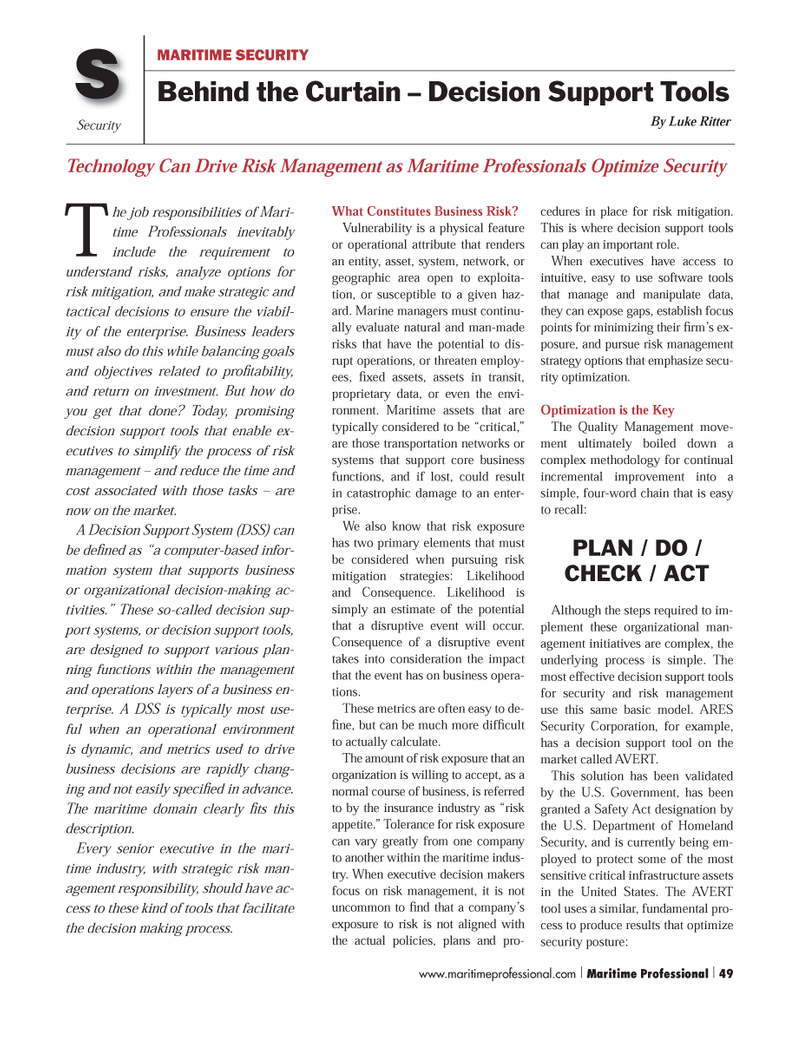
Page 49: of Maritime Logistics Professional Magazine (Q4 2013)
Shipbuilding, Repair
Read this page in Pdf, Flash or Html5 edition of Q4 2013 Maritime Logistics Professional Magazine
What Constitutes Business Risk?Vulnerability is a physical feature or operational attribute that renders an entity, asset, system, network, or geographic area open to exploita- tion, or susceptible to a given haz- ard. Marine managers must continu-ally evaluate natural and man-made risks that have the potential to dis- rupt operations, or threaten employ- ees, Þ xed assets, assets in transit, proprietary data, or even the envi- ronment. Maritime assets that are typically considered to be Òcritical,Ó are those transportation networks or systems that support core business functions, and if lost, could result in catastrophic damage to an enter- prise. We also know that risk exposure has two primary elements that must be considered when pursuing risk mitigation strategies: Likelihood and Consequence. Likelihood is simply an estimate of the potential that a disruptive event will occur. Consequence of a disruptive event takes into consideration the impact that the event has on business opera- tions. These metrics are often easy to de-Þ ne, but can be much more difÞ cult to actually calculate. The amount of risk exposure that an organization is willing to accept, as a normal course of business, is referred to by the insurance industry as Òrisk appetite.Ó Tolerance for risk exposure can vary greatly from one company to another within the maritime indus-try. When executive decision makers focus on risk management, it is not uncommon to Þ nd that a companyÕs exposure to risk is not aligned with the actual policies, plans and pro-cedures in place for risk mitigation. This is where decision support tools can play an important role. When executives have access to intuitive, easy to use software tools that manage and manipulate data, they can expose gaps, establish focus points for minimizing their Þ rmÕs ex- posure, and pursue risk management strategy options that emphasize secu- rity optimization.Optimization is the Key The Quality Management move- ment ultimately boiled down a complex methodology for continual incremental improvement into a simple, four-word chain that is easy to recall: PLAN / DO / CHECK / ACTAlthough the steps required to im-plement these organizational man- agement initiatives are complex, the underlying process is simple. The most effective decision support tools for security and risk management use this same basic model. ARES Security Corporation, for example, has a decision support tool on the market called AVERT. This solution has been validated by the U.S. Government, has been granted a Safety Act designation by the U.S. Department of Homeland Security, and is currently being em- ployed to protect some of the most sensitive critical infrastructure assets in the United States. The AVERT tool uses a similar, fundamental pro- cess to produce results that optimize security posture: SecurityMARITIME SECURITY Behind the Curtain ? Decision Support Tools SBy Luke Ritter Technology Can Drive Risk Management as Maritime Professionals Optimize Security The job responsibilities of Mari- time Professionals inevitably include the requirement to understand risks, analyze options for risk mitigation, and make strategic and tactical decisions to ensure the viabil- ity of the enterprise. Business leaders must also do this while balancing goals and objectives related to proÞ tability, and return on investment. But how do you get that done? Today, promising decision support tools that enable ex- ecutives to simplify the process of risk management Ð and reduce the time and cost associated with those tasks Ð are now on the market. A Decision Support System (DSS) can be deÞ ned as Òa computer-based infor- mation system that supports business or organizational decision-making ac- tivities.Ó These so-called decision sup- port systems, or decision support tools, are designed to support various plan- ning functions within the management and operations layers of a business en- terprise. A DSS is typically most use- ful when an operational environment is dynamic, and metrics used to drive business decisions are rapidly chang- ing and not easily speciÞ ed in advance. The maritime domain clearly Þ ts this description. Every senior executive in the mari- time industry, with strategic risk man- agement responsibility, should have ac- cess to these kind of tools that facilitate the decision making process. www.maritimeprofessional.com | Maritime Professional | 49MP #4 34-49.indd 49MP #4 34-49.indd 4912/11/2013 1:33:23 PM12/11/2013 1:33:23 PM

 48
48

 50
50
